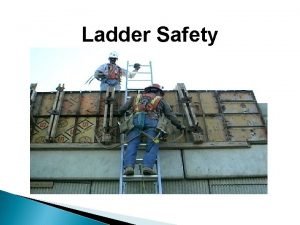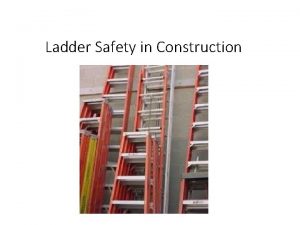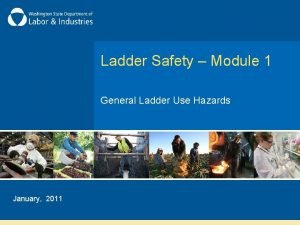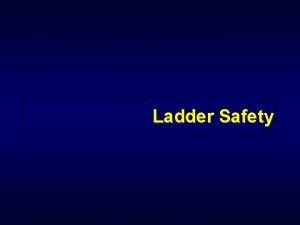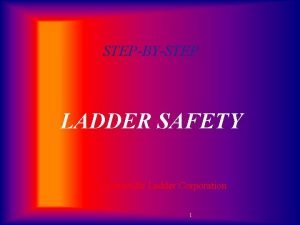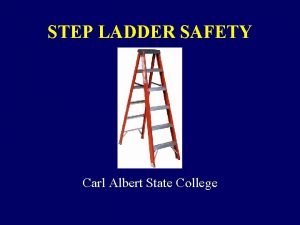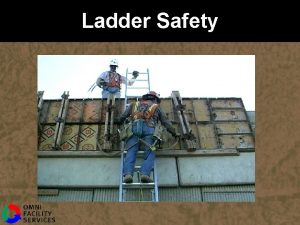Ladder Safety Copyright 2012 American Safety Management Inc


















- Slides: 18

Ladder Safety Copyright © 2012 American Safety Management Inc.

Injury Statistics • About 350 people are killed from ladder falls each year and 90, 000 are injured • Twice as many falls occur descending as compared to ascending • Main cause of single/extension ladder falls is sliding of base of ladder • Main cause of step ladder falls is tipping sideways • These accidents are preventable if you follow proper ladder safety procedures!

Major Hazards • Main hazard is falling from ladder • Back injuries from lifting heavy ladder second highest cause of injury • Other hazards include: – Struck by falling ladder/materials – Tripping over ladder – Striking person/object while carrying ladder – Contact with electrical equipment

Main Types of Ladders • Stepladder • Single Ladder • Extension Ladder *Ladders can be made from wood, aluminum, steel, or fiberglass

Stepladders • Self-supporting • Not adjustable in length • Not allowed to be used if longer than 20’ • Must be equipped with a metal spreader or locking device • Never use in unfolded position

What’s Wrong with this Picture?

Single Ladders • Not self-supporting – Must be leaned against object • Not adjustable in length • Not allowed to be used if longer than 30’

Extension Ladders • Not self-supporting • Adjustable length – Must have 2 locking mechanisms (one on each side of ladder) • Not allowed to be used if longer than 60’

Setting Up a Ladder • Before setting up any ladder, inspect it for defects, DO NOT use if any defects are found • Whenever possible sue 2 people to carry and set up ladder • Keep ALL types of ladders at least 10’ from all power lines and overhead obstructions (In certain conditions, any ladder can conduct electricity)

Setting Up a Ladder • Always place ladder on firm level ground • Use slip resistant feet or have a person hold ladder to secure base • If that is not possible, tie ladder off to secure anchor point • Keep area around ladder free from obstructions • If in traffic areas, put up signs to warn people of ladder in the area • Never place ladder on other objects, i. e. scaffold, box, pallets, etc.

Setting Up a Ladder • Stepladders must have all 4 legs on solid, level ground with spreader fully open • Single/Extension Ladders should observe 4: 1 ratio – The base should be 1 foot out from building for every 4 feet of height • Must extend at least 3’ past working surface

Using a Ladder • Always check a ladder before using it and anytime you have left and returned to it later • Always face a ladder when climbing up or down • Wear shoes with slip resistant soles and make sure rungs are free of grease, mud, water, etc. • Always maintain 3 points of contact – 1 hand, 2 feet – 2 hands, 1 foot

What’s Wrong with This Picture?

Using a Ladder • Keep yourself centered on ladder • Never stand on top 3 rungs of a single/extension ladder • Never stand on top step or on top of stepladders • Avoid using ladders in windy conditions • Never move ladder while someone is on it

What’s Wrong with this Picture?

Using a Ladder • Never attempt to move ladder while you’re on it • Lower extension ladders before moving • Never carry tools or materials up/down ladder • Either use tool belt or a hoist system to bring tools up to working surface

Maintenance • Wood: – Do not paint (could be defects) – Check for cracks, rot, splinters, broken rungs, and loose joints • Aluminum/Steel: – Check for rough burrs, sharp edges, faulty welds or cracks – Replace worn/frayed ropes on extension ladders • Fiberglass: – Should maintain a surface coat of lacquer – Check for any cracks or splinters

Key Points • Always inspect a ladder before use • Ladders are disposable items • Do not use a ladder unless you have been properly trained
 Dentist copyright 2012
Dentist copyright 2012 Copyright 2012
Copyright 2012 Clean leader
Clean leader Copyright 2012
Copyright 2012 Pearson education inc. publishing as prentice hall
Pearson education inc. publishing as prentice hall 2012 pearson education inc
2012 pearson education inc 2012 pearson education inc
2012 pearson education inc 2012 pearson education inc
2012 pearson education inc Olecranal region
Olecranal region 2012 pearson education inc
2012 pearson education inc Pearson education inc. 2012
Pearson education inc. 2012 2012 pearson education inc anatomy and physiology
2012 pearson education inc anatomy and physiology 2012 pearson education inc
2012 pearson education inc 2012 pearson education inc
2012 pearson education inc Pearson education 2012
Pearson education 2012 2012 pearson education inc
2012 pearson education inc Pearson education inc. 2012
Pearson education inc. 2012 2012 pearson education inc
2012 pearson education inc 2012 pearson education inc
2012 pearson education inc




















